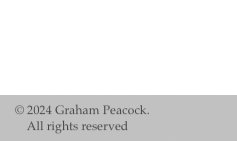 |
 |
||||
Graham Peacock surmounts a decade-old challengeThe Edmonton Journal. January 03, 2003 No one can accuse painter Graham Peacock of taking shortcuts. "It takes me two or three days just to mix my colours and pour the paints onto the canvas. I'll mix up to 30 gallons of a colour at one time, making my own gels as well," the leading abstract expressionist says of the first phase in the construction of his layered acrylic canvases. After the initial pours are complete -- working in a special 60-foot-long frame specially constructed for this act, and using custom-built paint-spreading tools -- comes a drying time of 10 to 21 days. Not that one should assume that this protracted drying period is a passive time in his Rice Howard Way studio. Far from it, asserts the fine artist who moved from England to Edmonton in 1969. Now 57, he's a professor at the University of Alberta. Given that a major component of his practice is working with the different rates of shrinkage from one layer of colour to the next, the drying period sees a certainamount of "guiding" take place as Peacock helps the process along as best he can. "Then, I tack the canvas on the wall and the compositional moment begins," he says, noting that the first decision made is to figure out the work's orientation (which end is top and bottom, left and right). "This is where I make that first interpretation of character and get the initial character of the piece. The whole process is very directional." Once ensconced on the wall, the editing period proper begins: the longest part of the process that can take anywhere from three weeks to three months. In that time, Peacock gives himself the freedom to do whatever it takes to move the canvas along to the place it needs to be. This editing process sees him collage bits of canvas from one section of the work to another (or even collage pieces of canvas from other works), as well as paint sections in or out of his vividly coloured works depending on where the piece seems to be moving. The collage process includes everything from totally unobtrusive elements that take close observation to determine if they're native to the canvas or not, all the way to highly whimsical, artificial additions (glass beads, glitter and foam peanuts). Of late, the painter has been giving his deeply organic pieces a definite topographical feel: the works boast an irregular edge (a "shoreline" created by the custom frames Peacock has built for each painting) and gentle undulations (filled out with foam) that give the canvases the appearance of islands appreciated from an aerial view. "I've always been a topographical painter, an abstract landscape artist creating floating forms." A deep dedication to the natural sciences dates back to a boyhood fascination with tidal pools that developed into a full-blown adult exploration of rheology (the study of the flow and deformation of matter, including elasticity, plasticity and viscosity) vital to his particular school of painting. "I'm part of the fluid school and the formation of my image is created using this dynamic flow of the medium. I'm letting the paint do some of my drawing and allowing the canvases to show me what they need done to them." Peacock is thrilled with his processes of late, noting that he's finding solutions for long-standing artistic concerns. "At the moment, I'm working on a canvas I'd started in 1992. I'm solving problems that were beyond me 10 years ago." As part of the North America-spanning New New Painters group, Peacock's work was recently on display in Europe and earned the group a major feature in the winter issue of Canadian Art Magazine. A selection of some of Peacock's newer, smaller collages on currently on display at the Vanderleelie Gallery (now in its new digs at 10183 112th St.). |
|||||